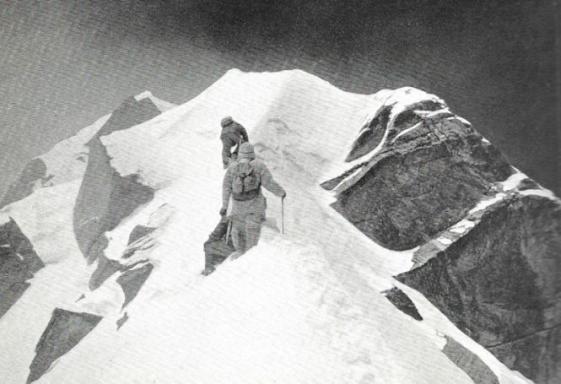May 1960. Ten years, almost to the day, after the first reconnaissance at the foot of the ‘White Mountain’, Dhaulagiri (8,167 m) was about to be climbed. The seventh highest peak on the planet, it is the last to resist its many contenders. Or to be more precise, the last summit accessible to the Western world. Shishapangma, also untouched but situated in Tibetan territory and off-limits to Westerners, had to wait until 1964 for Chinese climbers to set foot on its summit. First the Austrians and then the Swiss climbers solved the last major problem of the era in the Himalayas. But this time, victory would belong as much to the pioneers of mountain aviation as to the mountaineers themselves. A look back at the incredible adventure of pilot Ernst Saxer and engineer Emil Wick aboard the ‘Yeti’, the first Pilatus P-6 to land on the Himalayan glaciers.
See all our climbs above 8,000 meters.
14 May 1950, Tukuche in the Kali Gandaki valley
Council of war. Maurice Herzog and his comrades made the following observation: ‘Since 22 April, despite all our efforts, there has been no hope for us’. More than an expedition, he was leading a real exploration: false maps, unknown passes, the two coveted 8,000 m summits, Dhaulagiri and Annapurna, simply seemed inaccessible. From 24 April to 6 May, everyone was desperate to reach the more promising Dhaulagiri. Jacques Oudot and Lionel Terray arrived at the French Pass (5,360 m) and contemplated the north-east ridge and the north face. Terray: ‘The whole part of this slope that we could see was defended by huge, impassable serac bars [...]. At the briefing, the great Lionel Terray, author of ‘Conquérants de l'inutile’ (Conquerors of the Useless), even exclaimed: ‘No one will ever climb the north ridge, it's made of fast ice and the slope is so steep you'd have to carve handholds!
And yet...
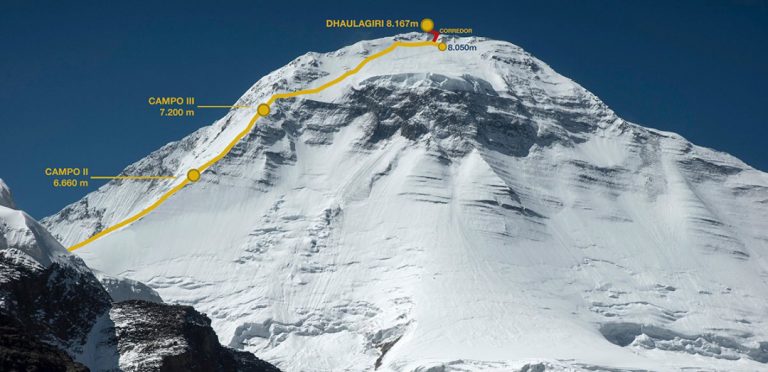
The route from the French pass
An unripe pear
In 1953, André Roch (Everest, the Swiss attempt in 1952) lost out to the English, who had set out to conquer the ‘Roof of the World’. In May 1953, instead of Everest, he was on the slopes of Dhaulagiri, this time up the long valley of the Myagdi Khola that runs into the French Pass. The Swiss set off on the north face, as the north-east ridge, described by Terray with awe and respect, still has a reputation for invincibility. To reach the foot of the ridge, you would have to climb the dangerous 700 meter high cascade of seracs from the Chhonbardhan glacier.
In the middle of the north face, a pear-shaped spur at 7,200 meters puts an end to their progress. For another seven long years, all the expeditions (Argentinian in 1954 and 1956, Swiss-German in 1955, Swiss again in 1958) persisted on this route. They all failed, more or less, at the ‘pear’.
1958: Max Eiselin's good intuition
Buried on the ‘pear’ route at 6,550 meters with Pasang Lama, in an ice cave blocked by an avalanche, Max Eiselin, a 26-year-old Swiss, and his companion narrowly escaped the mountain. A few days later, from Muktinath, he became convinced, by carefully observing the north-east ridge, that it could hold the key to the problem. Especially as one of the members of the 1953 Swiss expedition, Bernhard Lauterburg, had already managed to make his way up the icefall. At its summit, a huge plateau would provide an ideal advanced base camp for setting off along the north-east ridge. An idea of genius occurred to him. In 1952, a 38-year-old Swiss from the Valais region achieved a feat: Hermann Geiger was the first pilot to land on the slopes of a glacier, flying a small single-engine plane. Since then, he and his mountain rescue company have been the talk of the town. Max Eiselin decided to persuade him to come and land on the plateau, at a record altitude of 5,700 meters of altitude!
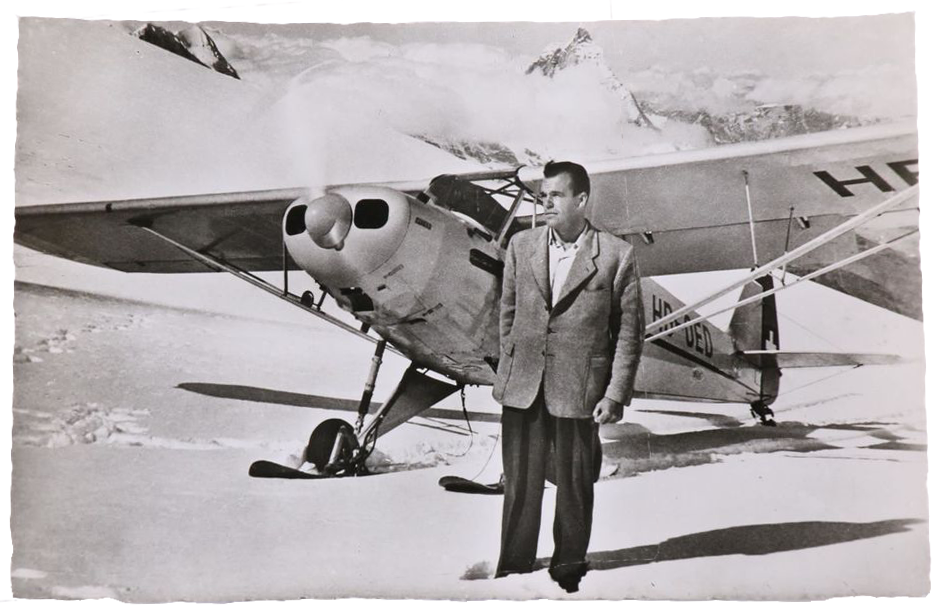
Hermann Geiger, pioneer of mountain aviation
Fritz Moravec, 1959: the aborted victory
Fritz Moravec, the Austrian who won Gasherbrum II in 1956, obtained a permit to climb Dhaulagiri in 1959. His goal: the now almost classic ‘pear’ route. With the undeniably sporting spirit that seems to be typical of the Swiss, Max Eiselin himself steered them towards the north-east ridge, taking the risk of seeing victory slip from his grasp. The Austrians, demoralised by the fatal accident of one of their climbers, then immobilised by bad weather 300 meters from the summit, had to give up. But they confirmed that the route to the summit was the north-east ridge. And the biggest difficulty was getting over the icefall to reach the col at the foot of the ridge, at the end of the large plateau. The route is clear, but the pilot is missing... and a few climbers!
The ‘Yeti’, the first Pilatus in the Himalayas
Hermann Geiger, who thought the landing was possible, was unable to be away for the 2 or even 3 months required for the project. Ernst Saxer, a young military pilot and instructor, only 23 years old, let himself be tempted by the adventure. Max Eiselin also recruited 12 mountaineers. Kurt Diemberger (28), Hermann Buhl's Austrian climbing companion on Broad Peak and Chogolisa, approached him. Once again, Max Eiselin, who could have limited himself to Swiss climbers, showed great open-mindedness (in the context of the national expeditions of the time) and integrated him into the group, along with two Polish mountaineers. To compensate for any possible shortcomings of Ernst Saxer, a co-pilot and mechanic, Emil Wick (33), was hired at the very last moment.
As for the aircraft, it was to be a Pilatus P-6 Porter STOL (Short Take-Off and Landing), which had already proved its worth on glaciers: it landed facing the slope, then took advantage of it to take off again. Less than one hundred and fifty metres of level ground is all it takes to land. Finally, some encouraging news: the Nepalese government has given the go-ahead for these experimental flights. The proximity of Tibet (less than 30 kilometres away) made this authorisation highly unlikely.
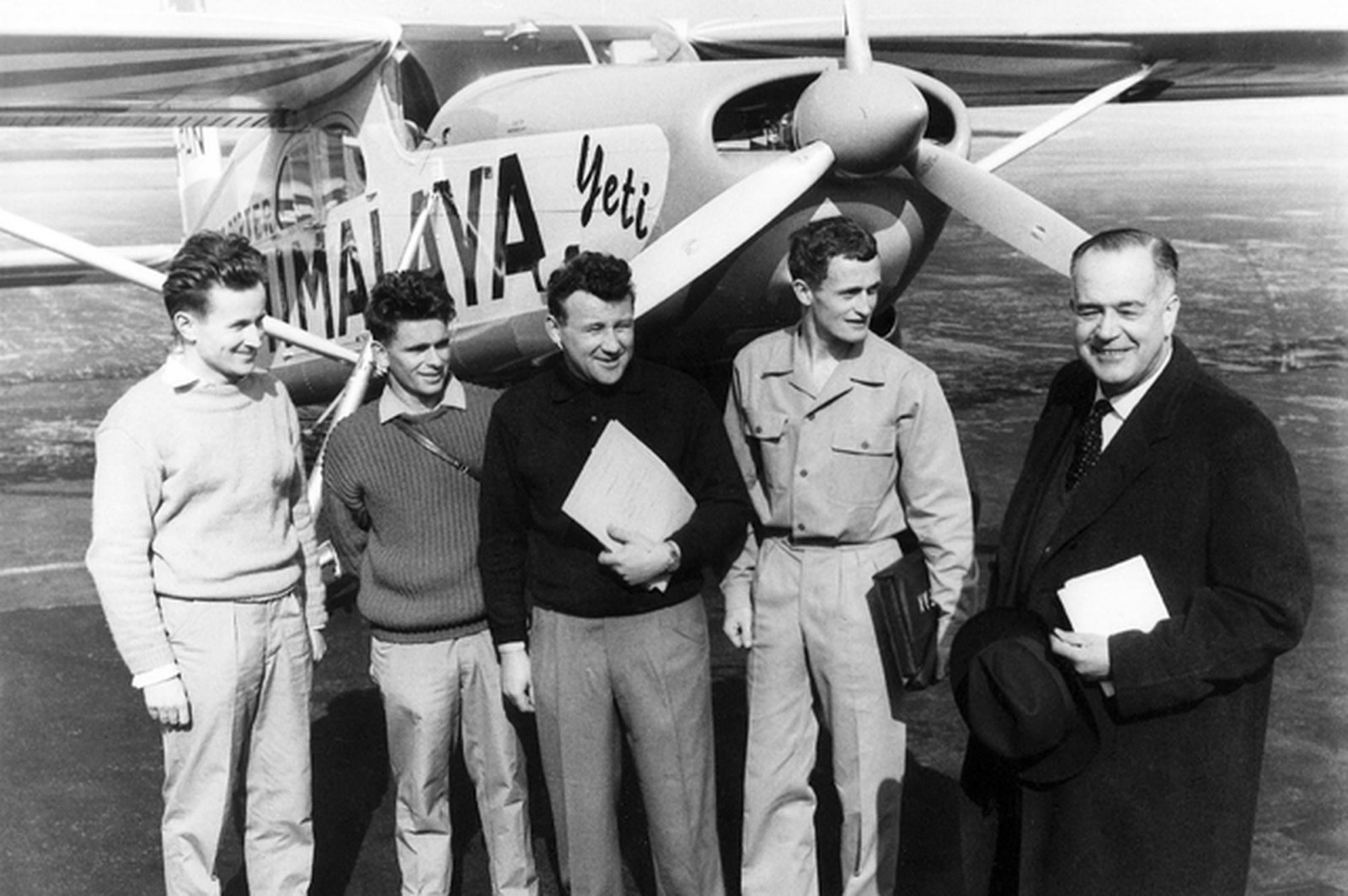 Max Eiselin and Peter Diener, pilots Max Wick and Ernst Saxer,
Max Eiselin and Peter Diener, pilots Max Wick and Ernst Saxer,
with Henry Alioth, Pilatus director, on departure from Zurich.
Halfway around the world in nine days
From 12 to 20 March 1960, in an astonishing journey that Jules Verne's hero Phileas Fogg would not have disowned (Around the World in Eighty Days), the frail Pilatus carried its two pilots, accompanied by Max Eiselin and the mountaineer Pieter Diener, passengers who were not always reassured, along the ten thousand kilometres separating Zurich from Kathmandu. All of this in ‘visual’ flight, in short hops, at a maximum of two hundred and fifty kilometres an hour, using a simple direction finder for guidance. Saint Exupéry, almost. Quite a feat in itself.
Just imagine: no fewer than fifteen improbable stopovers, punctuated by flights over Italy, the Mediterranean, the deserts of Arabia, the plains of Pakistan and India, enabled them to reach Delhi and then Kathmandu, where they landed on 20 March. On their arrival, only the cameraman, Norman Dyrenfurth, who had come specially from the United States, greeted them.
Five other members of the team, who had left two weeks earlier by boat via Bombay and then by train with the equipment, were held up somewhere in India, probably because of administrative hassles.
First reconnaissance flights
It was time for the first reconnaissance flights. The only possible landing ‘fields’ were the Dhampus Pass (5,260 m) and, much higher up and further away, the snowy saddle of the North-East Col (5,700 m). For obvious reasons of acclimatisation, they will first have to set up camp at Dhampus Pass, then make airborne rotations towards the pass. But everything depends on the Pilatus and the skill of its pilot. If it fails, they will have to follow the long and difficult route through the Hidden Valley to the French Pass, then climb the famous serac chute. A double or nothing gamble.
Back in Kathmandu: the good news is that the rest of the team and their equipment have arrived in Nepal, at the Indo-Nepal border to be precise. In 1960, there was still no road linking the capital to the border, and although Pokhara had a small landing strip, there was no oil... The Pilatus would have to shuttle back and forth between the border and the mountains.
Successful landing at Dhampus pass
28 March 1960: a date to be written in red letters in the history of mountain aviation. The Pilatus dropped off the first mountaineers and a load of equipment at the Dhampus pass, an essential acclimatisation camp. Then it was off again. Eiselin: ‘The Yeti hurtles down the slope towards Tukuche, at full speed, like a skier from the top of a ski jump’. From that day on, the Pilatus played a crucial role, transporting all the equipment and members of the expedition, along with their seven Sherpas, from the border to the acclimatisation camp. It is also a vital link between the men up there and the valley. In less than thirty minutes, an injured or sick person can be evacuated.
Later, an ‘air bridge’ with a Dakota from India would bring the oil essential for the Pilatus to Pokhara. No more shuttles to the border.
.jpeg)
The Pilatus departing from the Dhampus pass © Max Eiselin
Good for the Guinness World Records
A few days later, well acclimatised, everyone could look forward to reaching the north-east pass. Pilot Ernst Saxer, on his first flight over the pass: ‘It's going to be a piece of cake’...
To this day, the Pilatus Porter P-6 ‘Yeti’ still holds the world record for the highest landing by a single-engine fixed-wing aircraft, high up on the Dhaulagiri glacier at 5,700 meters of altitude.
On the mountain
From this well-situated advanced base camp, the ascent of the north-east ridge proper can begin. Not only had they bypassed the cascade of seracs from the glacier, but they had also avoided the fearsome rockfalls from the ‘Little Eiger’, a wall so nicknamed because of its resemblance to the famous mountain in the Bernese Oberland. The climbers and their Sherpas take it in turns on the windswept slopes to set up four camps. In the meantime, the Pilatus continued to rotate almost every day, interrupted however by a breakdown that necessitated a complete engine replacement!
The last flight of the Pilatus
The first incident occurred when the ‘Yeti’, slowed down by deep snow, failed to take off from the snowy saddle at the north-east col. The mountaineers had to pack the snow down to the very edge of the crevasses to allow it to take off, almost ending in disaster. A few days later, on 5 May 1960, during take-off from the Dhampus pass, Ernst Saxer found himself with the knob of the joystick in his hand, broken clean off. He could no longer control the ‘Yeti’, which hit the rocks violently and was seriously damaged: propeller bent, engine, wings and tailplane destroyed. Fortunately, both pilots escaped with bruises, but had to make their own way back to Tukuche. Emile Wick recalls: ‘We are the only people to have descended the Dhaulagiri without ever having climbed it...’.
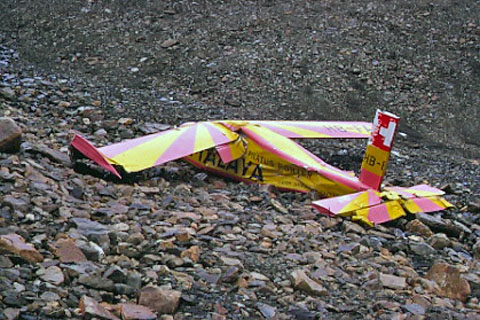
The Pilatus under the Dhampuss pass after its accident, 1964 © Don Messerschmidt
On the north-east ridge
Deprived of the Pilatus and very worried about the fate of the two pilots, the climbers nevertheless continued to make progress, despite the violent winds and frequent snowfalls. Camp I: 6,600 m; camp II: 7,050 m; camp III: 7,400 m; and camp IV: 7,800 m, where a single tent provided rough shelter for six men.
Kurt Diemberger: ‘From the wide snowy plateau, the icy ridge rises gently at first, then more and more steeply. On the left, a wall of ice at 60 degrees, on the right a band of rocks in an inverted triangle. At around 7,000 meters, a hundred meters rocky bar requires the use of fixed ropes. Beyond this, the slope becomes gentler, then steepens again at around 7,400 meters. At 7,800 meters, the north-east and south-east ridges meet. A final long aerial traverse, interspersed with a few mixed passages, leads to the summit, which is wide enough for several people.
13 May 1960, the summit
On the morning of 13 May, the strangely calm and serene weather allowed them to reach the summit. In 4 and a half hours, Kurt Diemberger, Albin Schelbert, Nawang Dorje, Ernst Forrer, Nima Dorje and finally Peter Diener, starting from camp IV, reached the summit. On 23 May, Michel Vaucher and Hugo Weber, directly from camp V, also succeeded. The Montagne Blanche had given way.
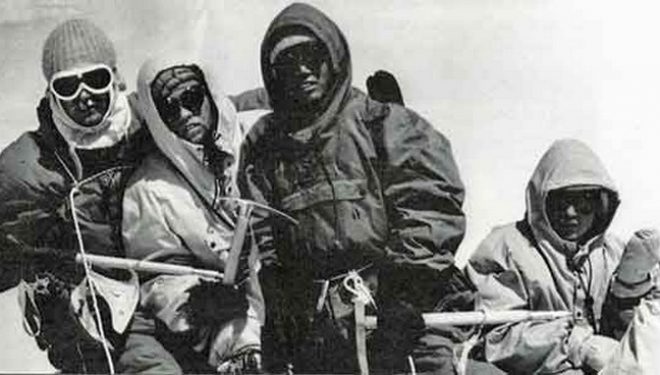
Albin Schelbert, Nawang Dorje, Nima Dorje, Ernst Forrer at the summit © Kurt Diemberger
The icing on the cake was that no oxygen was used during the ascent. And with good reason: the cylinders, transported from Switzerland, mysteriously emptied before they even reached base camp!
Epilogue
No other expedition would attempt such a crazy feat.
In the early 2000s, a team of enthusiasts set out to bring back some of the plane's components. They planned to exhibit them in a museum in Switzerland. Unfortunately, after 40 years at altitude, in the cold and damp, not much remains of the aircraft.
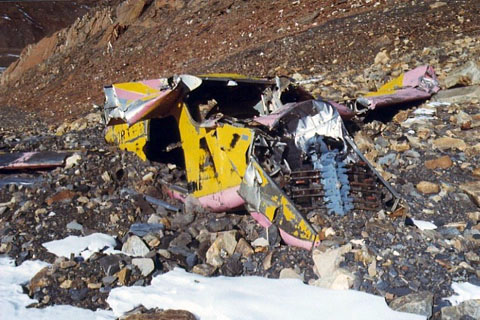
The carcass of the Pilatus in 2000 © Karl Scheuber
Join our next expedition for Dhaulagiri (8,167 m)
To find out more about preparing for an 8,000-meters ascent, we recommend this interview with Bernard Muller, one of France's most renowned expedition leaders at very high altitude:
Text by Didier Mille.

Climb Dhaulagiri at 8167 meters in Nepal

Climb Lhotse at 8516 meters in Nepal
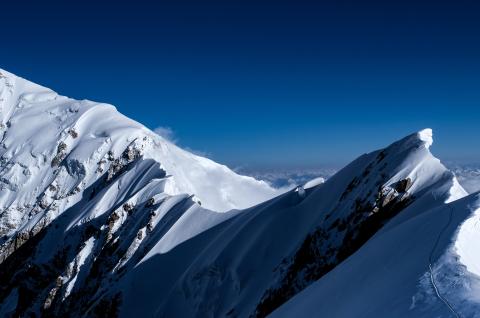

 Expeditions Unlimited blog
Expeditions Unlimited blog